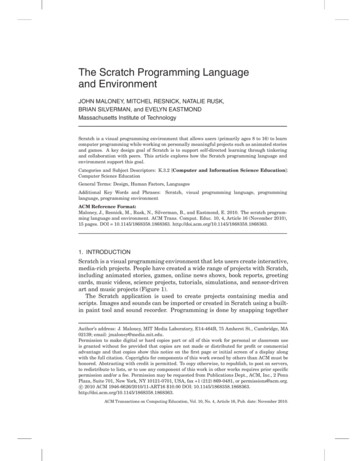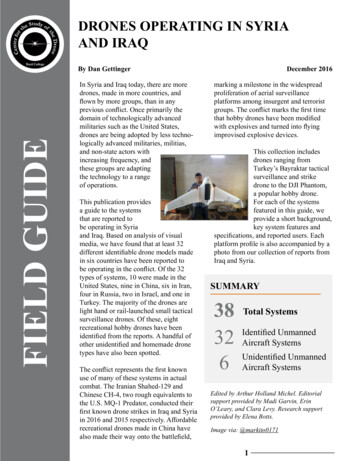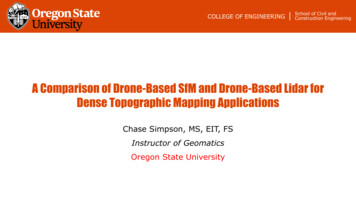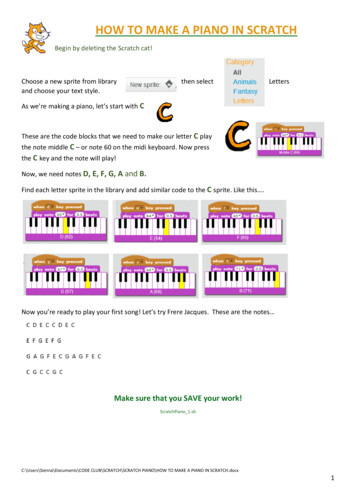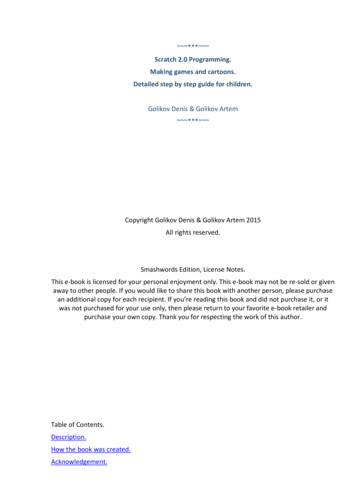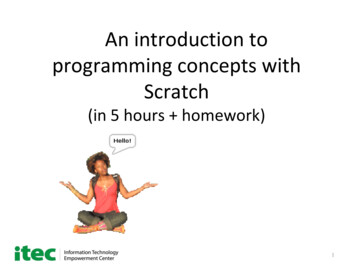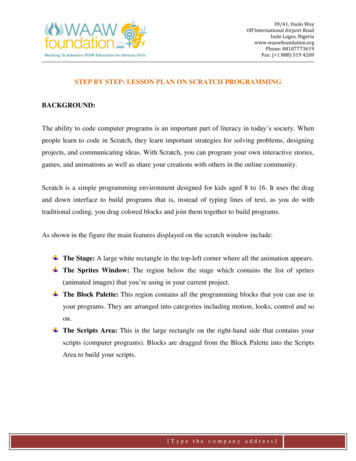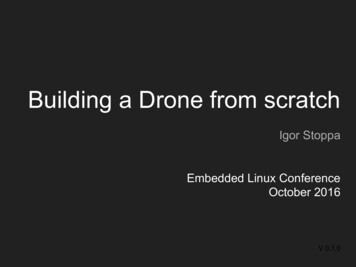
Transcription
Building a Drone from scratchIgor StoppaEmbedded Linux ConferenceOctober 2016V 0.1.0
DisclaimersOpinions expressed in these foils represent exclusivelyto the author’s view.All Logos and Trademarks represented belong to theirrespective owners.
Summary Intro - what is this about? - why from scratch?Setting the GoalsRequirements: must have, nice to have, long termIdentifying the constraints: time, materials, means.System design: centralized / distributed, make / buyThe gory details: HW / SW selection, system architecture Dealing with physical systems:motors in real life, inertia, max battery power Ideas for future expansion
Intro - what is this about? Learning-by-doing project Attempt to build a drone of acceptable quality, while: keeping the cost low; keeping the overall complexity low; using off-the-shelf components easily obtainablethrough major worldwide retailers. achieving sufficient modularity to support variousconfigurations
Intro - Why from scratch? Many frameworks available, trying to hide thecomplexity.Useful for productization, less open to free formexperimentation. SW platforms tend to focus on specific HW.It simplifies the design and the verification, at theexpense of freedom of choice. It’s more interesting Challenge: use the most out of the HW selected
Setting the Goals4WD Drone:less glamorous than flying, but less likely to break.Easy upgrade path:no proprietary solutions, compartmentalize functionality.Low cost:stock parts from popular kits, SW to improve accuracy.Ease of debug:tap into standard interfaces between building blocks.
RequirementsMust HaveSpeed control, Steering, Remote ControlNice to HaveObstacle detection, Obstacle avoidance, camera streamLong TermRemote Computer Vision, Onboard Computer Vision
Constraints to DevelopmentLimited timeOnly few hours per week, each week a new feature.CostsIt shouldn’t break the bank, especially when taken aseducational tool/toy. This includes the tools used.MaterialIt should rely only on components readily available ataffordable price, through worldwide distribution channels.
System DesignExtensibilityAllow additional HW features. Ex: accelerometer.ModularitySegregation of different functionality.Ease of unit-test and debug, less interference.Real time responseDeterministic cap to reaction times, in specific cases.Power EfficiencyMinimize power loss in major use cases (DC motors).
System Design - continuedLow MassMinimize negative effects of inertia:- higher power (peak current) required to alter the state(steer, speed up/down)- higher chance to driftCircumscribe electrical damageIn case of electrical fault (misconnection/short, etc.),preserve the most expensive component(s) fromdamage.
Single Board vs Multiple BoardsComparisonSingle Board Multi-BoardsExtensibilityLessYesPower EfficiencyYesLessLow MassYesLessModularityLessYesReal time ResponseLessYesDamage ControlLessYes
ConsiderationsThere is no perfect solution - unsurprisingly.Both can be made to work, with ad-hoc adjustments.The Multi-Boards approach wins because: It is better at protecting the “Main” board. It can even omit the “Main” board - ex: simple RC drone. It enables the use of an RTOS for the time-sensitive tasks.
Overall System ArchitectureWIFI or other radioVccMainBoardPullUpI2C BusMOpticalencoderMicroController 1Board.MicroController nBoard
BoardReceiverMicroControllerBoardI2C BusMOpticalencoderMicroController 1Board.MicroController nBoard
Power Distribution - 1 BatteryMotorsDriver9V regulated5VregulatedControlLogic
Power Distribution - 1 Battery1 single battery for powering both logic and actuators Actuators can try to draw more current than the batteryprovides while accelerating. Ex: inversion of rotation, start. Voltage across the battery pack can drop. The drop can be enough to starve the regulator feedingthe logics.Solution: limit the max current used by the actuators.
Power Distribution - 1 BatteryMotorsDriver9V regulated withcurrent limiter [7]5VregulatedControlLogic
Motors - optionsDC Motor Pros: fast, naturally continuous, robust. Cons: needs additional circuitry for speed/position controlServo Motor Pros: fast, high torque Cons: needs modification to be continuous, can vibratewhen idle, more expensive.
Choice: DC MotorOptical EncoderDC MotorOpticalCouplerGear BoxWheelFrequency proportionalto the rotation speed
Optical CouplerEnd Stop for 3D printerTCST2103 [1] Fairly cheap Sufficiently accurate Compatible with thedimensions of the opticalencoder.
Driving DC motors - H bridgeS1S3MVinS2S4 Allows to apply voltageacross a load in eitherdirection. Various technologies usedto implement S1.S4 Different levels ofefficiency.
Driving DC motors - signalsCH-AMicroController 1BoardDC MotorDriverCH-BCH-A/B(A/B)O2 (A/B)O1(A/B)IN2(A/B)IN1PWM(A/B)00DON’T CAREFREE SPINNING01PWMCLOCKWISE10PWMCOUNTER CLOCKWISE11DON’T CARELOCKED
Motors Drivers - options [2]L298N Cheap Big Internal Power Loss Large (HeatSink)TB6612FNG More expensive Small Internal Power Loss Small (no need todissipate power)
Low Level Automation - uCArduino Pro Mini (AVR328p)[3] Has I2C interface Sufficiently powerful toperform the requiredcalculations For each motor: Drive status Dedicate PWM line Optical Encoder input
Motor Control and FeedbackMotor status control 2 independent GPIOs for each motorPWM 2 independent counters, each feeding into 2 dividers Independent control for each motor, allows for calibrationOptical Encoder input 1 GPIO for each motor encoder, as IRQ, to avoid polling Only the counters are bumped in IRQ context, the rest asbottom half
Proximity SensorBat-like: send a burst of waves, waits for the echos [8]2cm - 400cm range15 degrees apertureTriggerPingsEcho
Proximity SensorCreate pairs that do notinterfere with each other.Activate the pairs clockwise.Possible improvement: createdouble pairs that areorthogonal.
Running the microControllermain() Program Main loop with functions interrupt handlers8-bit RTOS Interrupt handlersTasks SchedulingSemaphoresMailboxes
RTOS selectionFreeRTOS [4] GPLv3 for non commercial Only for ATMega323,but not for ATMega328p Many (mostly dead)unofficial ports to Mini Pro Not very small memoryfootprint.ChibiOS [5] GPLv3 for non commercial Essential BSP for Mini Pro Small footprint
I2C Development and DebuggingHW tools summary: HW debugger/flasher - AVR Dragon Bus low level protocol analyzer/snooper Bus Pirate Logical analyzer - SigRok Pulseview USB scope - Hantek OpenhantekFull dissertation on I2C from ELC NA 2016 [6].
I2C High Level Protocol debuggingNeed to createcustom tools, fornon-trivial testingof both theprotocol and theimplementationof the API.
Main Board SelectionRequirements It must run linuxLow power consumptionI2C interface - masterWiFi interfaceSmall form factorUSB OTG/Master
Main Board SelectionOptions Intel Edison [9] Pros: powerful, small. Cons: , modules Next Thing CHIP [10] Pros: cheap Cons: delayed Intel Joule [11] Pros: powerful Cons: ,Geppetto PCB
Future AccelerometerOptical Flow cameras on the sidesComputer VisionGPSLIDARPort to quadcopter.
Questions?
Thank you!
Backup Info
C%20hacking%20demystified tchip.com/
Learning-by-doing project Attempt to build a drone of acceptable quality, while: keeping the cost low; keeping the overall complexity low; using off-the-shelf components easily obtainable through major worldwide retailers. achievin

